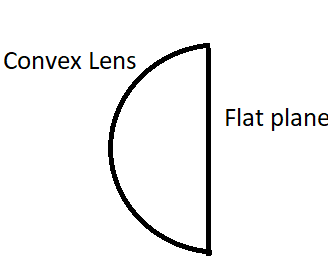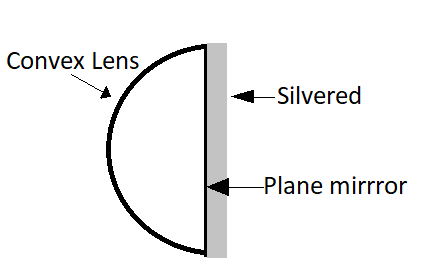
A plano-convex lens (f=20cm) is silvered at the plane surface. The new focal length will be:
A) 20cm
B) 40cm
C) 30cm
D) 10cm
Answer
218.4k+ views
Hint: A Plano-convex lens is a lens which is made by joining a flat plane and a convex lens.
Silvering of flat plane converts it into a mirror as now the light rays will be reflected by the lens instead of passing through after refraction.
The power of a lens is the ability of a lens to converge or diverge a ray of light falling on it.
Complete step by step solution:
The following images show how a Plano-convex lens looks like

Now when its plane part is silvered so it acts as a mirror now, refer the image

Here we can say that it is now a combination of a convex lens and a plane mirror both of which have their powers
The power of a Plano-convex lens is equal to the sum of twice the power of lens and mirror
i.e.,${P_{total}} = 2{P_{lens}} + {P_{mirror}}$
We know that power of a lens is given by ${P_{lens}} = \left( {\dfrac{1}{{{f_{lens}}}}} \right)$
Where ${f_{lens}}$is the focal length of the mirror
And the power of a plane mirror is given by ${P_{mirror}} = \left( {\dfrac{1}{{{f_{mirror}}}}} \right)$
Where ${f_{mirror}}$ is the focal length of the mirror
So total power of the setup will be
\[
\because {P_{total}} = 2{P_{lens}} + {P_{mirror}} \\
\therefore {P_{total}} = 2 \times \left( {\dfrac{1}{{{f_{lens}}}}} \right) + \dfrac{1}{{{f_{mirror}}}} \\
\]
Here the focal length of the lens is given as $20cm$
And we know that the focal length of a plane mirror is $\infty $
Substituting these values in the above equation
\[
{P_{total}} = 2 \times \left( {\dfrac{1}{{20}}} \right) + \dfrac{1}{\infty } \\
\Rightarrow {P_{total}} = \dfrac{1}{{10}} \\
\]
Here we get to know that the power of a plane mirror is zero because a plane mirror neither converges or diverges any ray of light falling on it just reflects them back.
Now as we know that the power is the reciprocal of the focal length so the new focal length corresponding to this power will be,
Let new focal length be $f`$
We know that
\[
{P_{total}} = \dfrac{1}{{f`}} \\
\therefore f` = \dfrac{1}{{{P_{total}}}} \\
\because {P_{total}} = \dfrac{1}{{10}} \\
\therefore f` = 10cm \\
\]
The new focal length of the Plano-convex mirror will be $10cm$.
Note: 1) The power of a lens depends upon its focal length
2) The focal length of a plane mirror is infinity and thus its power is zero
3) Silvering of any lens makes it a mirror because now it will reflect the light rays falling on it
Silvering of flat plane converts it into a mirror as now the light rays will be reflected by the lens instead of passing through after refraction.
The power of a lens is the ability of a lens to converge or diverge a ray of light falling on it.
Complete step by step solution:
The following images show how a Plano-convex lens looks like

Now when its plane part is silvered so it acts as a mirror now, refer the image

Here we can say that it is now a combination of a convex lens and a plane mirror both of which have their powers
The power of a Plano-convex lens is equal to the sum of twice the power of lens and mirror
i.e.,${P_{total}} = 2{P_{lens}} + {P_{mirror}}$
We know that power of a lens is given by ${P_{lens}} = \left( {\dfrac{1}{{{f_{lens}}}}} \right)$
Where ${f_{lens}}$is the focal length of the mirror
And the power of a plane mirror is given by ${P_{mirror}} = \left( {\dfrac{1}{{{f_{mirror}}}}} \right)$
Where ${f_{mirror}}$ is the focal length of the mirror
So total power of the setup will be
\[
\because {P_{total}} = 2{P_{lens}} + {P_{mirror}} \\
\therefore {P_{total}} = 2 \times \left( {\dfrac{1}{{{f_{lens}}}}} \right) + \dfrac{1}{{{f_{mirror}}}} \\
\]
Here the focal length of the lens is given as $20cm$
And we know that the focal length of a plane mirror is $\infty $
Substituting these values in the above equation
\[
{P_{total}} = 2 \times \left( {\dfrac{1}{{20}}} \right) + \dfrac{1}{\infty } \\
\Rightarrow {P_{total}} = \dfrac{1}{{10}} \\
\]
Here we get to know that the power of a plane mirror is zero because a plane mirror neither converges or diverges any ray of light falling on it just reflects them back.
Now as we know that the power is the reciprocal of the focal length so the new focal length corresponding to this power will be,
Let new focal length be $f`$
We know that
\[
{P_{total}} = \dfrac{1}{{f`}} \\
\therefore f` = \dfrac{1}{{{P_{total}}}} \\
\because {P_{total}} = \dfrac{1}{{10}} \\
\therefore f` = 10cm \\
\]
The new focal length of the Plano-convex mirror will be $10cm$.
Note: 1) The power of a lens depends upon its focal length
2) The focal length of a plane mirror is infinity and thus its power is zero
3) Silvering of any lens makes it a mirror because now it will reflect the light rays falling on it
Recently Updated Pages
Young’s Double Slit Experiment Derivation Explained

Wheatstone Bridge Explained: Working, Formula & Uses

Chemical Properties of Hydrogen - Important Concepts for JEE Exam Preparation

JEE General Topics in Chemistry Important Concepts and Tips

JEE Atomic Structure and Chemical Bonding important Concepts and Tips

JEE Amino Acids and Peptides Important Concepts and Tips for Exam Preparation

Trending doubts
JEE Main 2026: Application Form Open, Exam Dates, Syllabus, Eligibility & Question Papers

Derivation of Equation of Trajectory Explained for Students

Hybridisation in Chemistry – Concept, Types & Applications

Understanding the Angle of Deviation in a Prism

Understanding Collisions: Types and Examples for Students

Understanding Atomic Structure for Beginners

Other Pages
JEE Advanced Marks vs Ranks 2025: Understanding Category-wise Qualifying Marks and Previous Year Cut-offs

How to Convert a Galvanometer into an Ammeter or Voltmeter

Understanding Centrifugal Force in Physics

Ideal and Non-Ideal Solutions Explained for Class 12 Chemistry

Degree of Dissociation: Meaning, Formula, Calculation & Uses

Understanding Electromagnetic Waves and Their Importance




